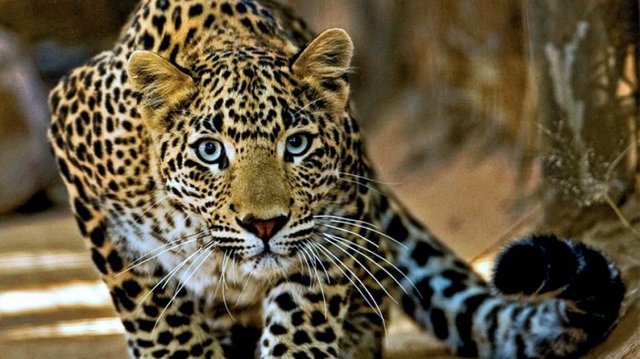Javan leoprd and Sumatran tiger from different characters
The Javan leopard, Panthera pardus melas, was the last big cat on the island of Java after the Javan tiger was declared extinct in the 1980s. The leopard is a legally protected animal and is globally classified as Critically Endangered on the IUCN Red List, one step towards extinction. The shrinking habitat and the threat of hunting are challenges for the preservation of the remaining Javan leopard. In addition, population data and the distribution of the Javan leopard itself are still minimal in availability and are still a homework for stakeholders, including researchers and the general public.
In general, it is known that the Javan leopard inhabits forests, both in conservation areas and outside the area. Its high adaptability allows the leopard to inhabit various types of habitats, as long as it provides food, protection and a partner for reproduction.
The West Java Natural Resources Conservation Center as the technical implementing unit of the Ministry of Environment and Forestry has the responsibility to manage the Conservation Area and the wild plants and animals in it. In order to carry out this task and strengthen leopard conservation, a habitat study and monitoring of the leopard population was carried out in the Cikepuh Wildlife Reserve and Cibanteng Nature Reserve in April-May 2020 together with the Sintas Indonesia Foundation and the IAR Indonesia Foundation.
From our findings, in general the Cikepuh SM Area (8,070.10 ha) and Cibanteng CA (459.95 ha) still have the potential to support the presence of leopards. Prey animals, water sources and adequate forest cover for shelter are still available. Using an occupancy survey approach, we conducted a study with a total transker length of 70.19 km which was carried out for 3 days in parallel by 4 teams in 13 imaginary plots (3.5 x 3.5 km) which completely divides the Cikepuh and Cibanteng areas. . A total of 4 of the 13 plots surveyed found leopard tracks in the form of footprints, claws and droppings along with the findings of prey animals and illegal acts that still occur in the Conservation Area. From these findings, it can be concluded that naively, the proportion of leopard habitation in Cikepuh and Cibanteng is 31% of the total area.
In addition to the habitat assessment, 17 units of surveillance cameras (cameratrap) were installed at 17 observation stations for a full month to monitor the presence and population of leopards. As a result, 5 unique individuals, 2 males and 3 females, were successfully recorded on camera in 4 different locations. Until now, we are still conducting further analysis to be able to estimate the population size of the Javan leopard that inhabits Cikepuh and Cibanteng.
Previously, efforts made in 2016, obtained 4 unique individuals, while in 2018 and 2019 only 1 individual. This year's findings are the most. However, this cannot be directly interpreted as an increase in population, although this possibility may occur. The updating of standardized observation methods may be one of the factors that makes the leopard more likely to be caught on camera. However, it is also undeniable that the succession process of a rehabilitation process in the Cikepuh area also has an important role in maintaining the leopard population, this is indicated by the increase in the types and locations of prey animals found.
In closing, this increasingly threatened Javan leopard Conservation cannot be fully fulfilled and achieved by the Ministry of Environment and Forestry alone. West Java BBKSDA will always be committed to being at the forefront of conservation with the community and of course with the support of all parties.

The cat tiger is the largest on earth. The Sumatran tiger is one of the sub-species of tiger that still survives today. This species can also be called the Sunda Tiger, the name "Sunda" refers to the biogeographic area that includes Sumatra, Java, and Bali. This species with the Latin name Panthera tigris sondaica (Wilting, 2015) has a relatively smaller body than other tiger subspecies, namely the Continental Tiger (Panthera tigris tigris). The Sumatran Tiger's skin color tends to be darker, ranging from reddish yellow to dark orange and has denser stripes. This animal is classified as Critically Endangered.
FISK CHARACTERISTICS
The Sumatran tiger has a relatively smaller body than the Continental Tiger (Panthera tigris tigris).
Adult males can reach a height of up to 60 cm and a length from head to toe of up to 250 cm and a weight of up to 140 kg. The female tiger has an average length of 198 cm and a weight of up to 91 kg.
The Sumatran Tiger's skin color is relatively darker, ranging from reddish yellow to dark orange, and has denser stripes.
WHY THIS SPECIES IS IMPORTANT
Riau Province is home to a third of the entire Sumatran tiger population. Unfortunately, despite being protected by law, the tiger population has continued to decline by up to 70% in the last quarter century. In 2007, it was estimated that there were only 192 Sumatran tigers left in the liar realm in Riau Province.
As a protected animal in Indonesia based on Law Number 5 of 1990 concerning Conservation of Biological Natural Resources and Their Ecosystems, the Sumatran tiger whose Latin name is Panthera tigris sondaica (Wilting, 2015) only has 400 individuals left. Its population is threatened by poaching and illegal trade. The snare became a scourge for the king of the jungle. Hunters use snares as their main means of hunting tigers because they are easy, cheap and large to get their prey.
WWF-Indonesia protects with the Government of Indonesia, industries that threaten tiger habitat, other conservation organizations and local communities to save Sumatran Tigers from extinction.
In 2004, the Government of Indonesia declared an important area, Tesso Nilo, as a National Park to ensure a secure future for the Sumatran Tiger.
In 2010, at the Tiger Summit in St. Petersburg, Indonesia and the 12 other countries that protect Tigers are committed to a conservation goal that has been set and visionary ever made: TX2 – to multiply the number of Tigers by the end of 2022, the next year of the Tiger.
Indonesia's National Tiger Recovery Program is now part of the global goal and covers the six priority landscapes of the Sumatran Tiger: Ulumasen, Kampar-Kerumutan, Bukit Tigapuluh, Kerinci Seblat, Bukit Balai Rejang Selatan, and Bukit Barisan Selatan.
WWF is currently conducting groundbreaking research on Sumatran tigers in Central Sumatra, using camera traps to estimate population size, habitat and distribution to find corridors of deceitful animals that need protection. WWF has also deployed anti-poaching patrol teams and units working to reduce human-tiger conflict in local communities.
HOW CAN HELP
learn and share information about the Sumatran tiger to raise awareness of the people around you
Announcement of Sumatran Tiger Death to local authorities
Support conservation efforts carried out by the Indonesian government, WWF-Indonesia and other conservation agencies.

